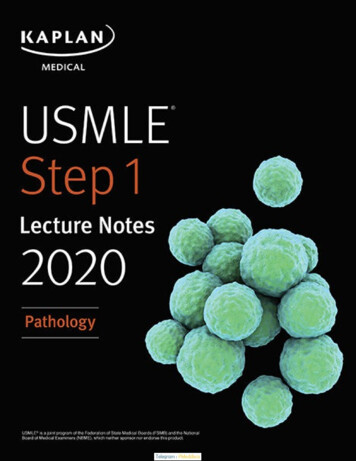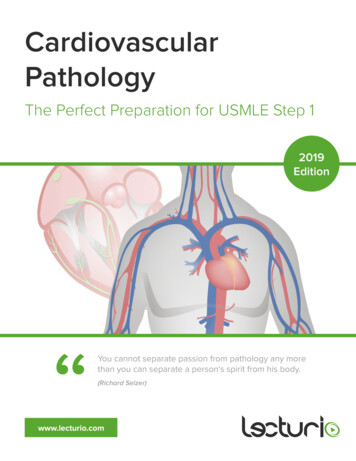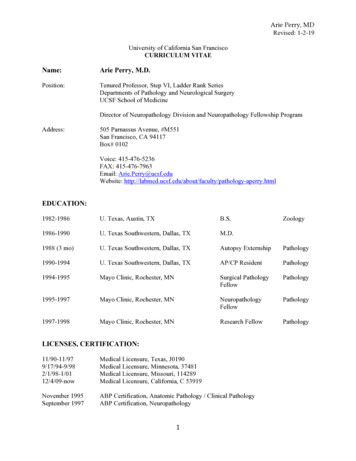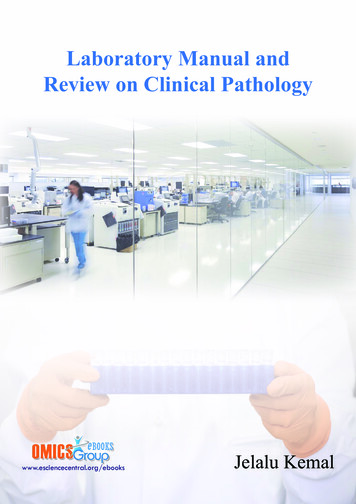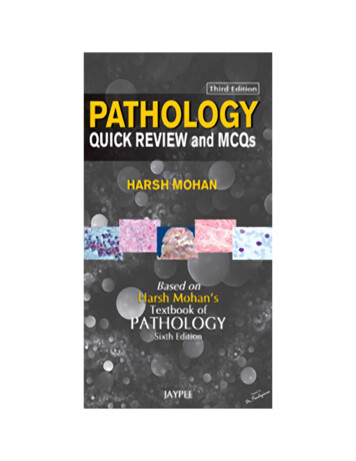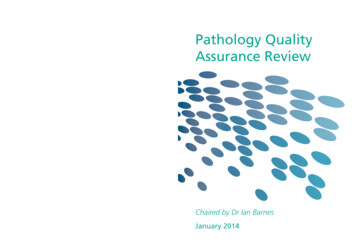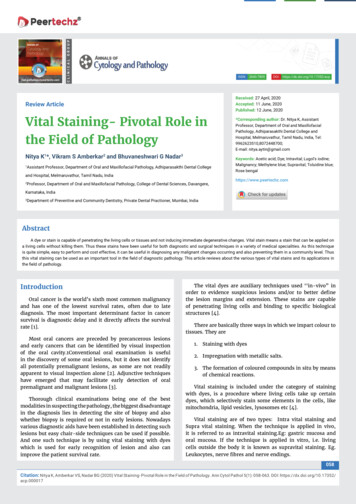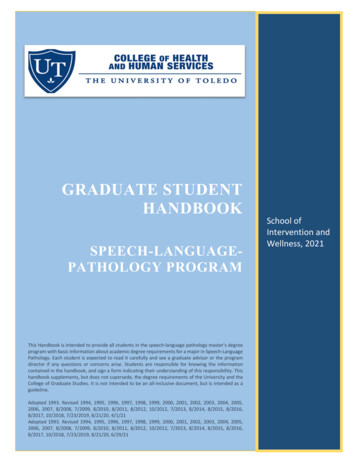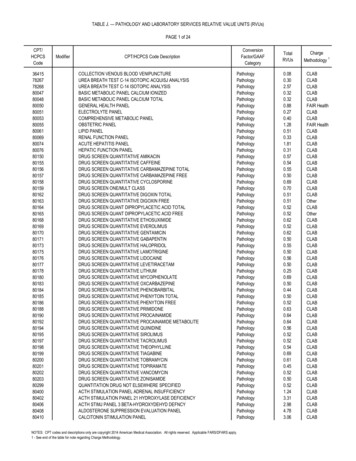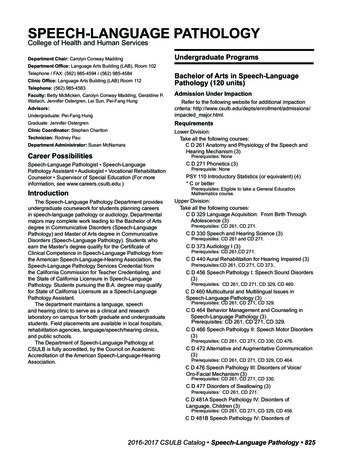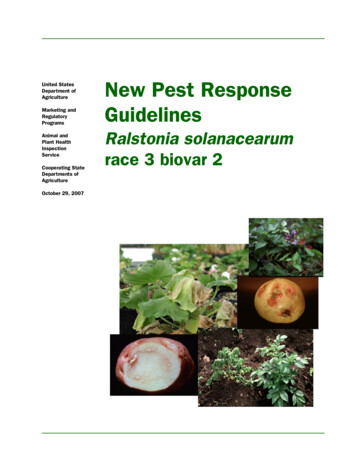
Transcription
United StatesDepartment ofAgricultureMarketing andRegulatoryProgramsAnimal andPlant HealthInspectionServiceCooperating StateDepartments ofAgricultureOctober 29, 2007New Pest ResponseGuidelinesRalstonia solanacearumrace 3 biovar 2
New Pest Response GuidelinesRalstonia solanacearum race 3 biovar 2October 29, 2007New Pest Response Guidelines: Ralstonia solanacearum race 3 biovar 2 wasprepared by Joel Floyd, USDA–APHIS–PPQ–Emergency and DomesticPrograms. The Guidelines was originally limited to geranium host plants, andwas issued on February 27, 2003.This updated Guidelines includes information on potato host plants. Cite theupdated report as follows: Floyd, J. 2007. New Pest Response Guidelines:Ralstonia solanacearum race 3 biovar 2. USDA–APHIS–PPQ–Emergency andDomestic Programs, Riverdale, Maryland. http://www.aphis.usda.gov/import export/plants/manuals/index.shtmlR. L. DunkleRichard Dunkle, Deputy AdministratorUSDA/APHIS/PPQEmergency and Domestic ProgramsEmergency PlanningJoel Floyd, Team Leader4700 River RoadUnit 137Riverdale, Maryland 20737Telephone: 310‐734‐4396Joel.P.Floyd@aphis.usda.govOctober 24, 2007
Ralstoniasolanacearum r 3 b 2CreditsContributorsPhilip Berger, USDA–APHIS–PPQ–Center for Plant Health Science andTechnology (CPHST), Raleigh, North CarolinaRuss Bulluck, USDA–APHIS–PPQ–Emergency and Domestic Programs,Raleigh, North CarolinaWilliam Callison (retired), California Department of Food and Agricultureand the National Plant BoardGene Cross, North Carolina Department of Agriculture and ConsumerServicesJoann Cruse, USDA–APHIS–PPQ, Madison, WisconsinRenee DeVries, USDA–APHIS–PPQ–CPHST, National Plant Germplasm &Biotechnology Lab, Beltsville, MarylandCharles Divan, USDA–APHIS–PPQ–Biological and Technical Services,Riverdale, MarylandLynn Evans‐Goldner, USDA–APHIS–PPQ–Emergency and DomesticPrograms (EDP), Riverdale, MarylandMike Firko, APHIS–PPQ–PHP–Permits, Registrations, Importers andManuals (PRIM), Riverdale, MarylandLloyd Garcia, USDA–APHIS–PPQ Eastern Regional Office, Raleigh, NorthCarolinaDavid Kaplan, USDA–APHIS–PPQ–EDP, Riverdale, MarylandLaurene Levy, USDA–APHIS–PPQ–CPHST, National Plant Germplasm &Biotechnology Lab, Beltsville, MarylandSteve Marquardt, North Dakota State University, Bismarck, North DakotaWendy Nelson, USDA–APHIS–PPQ–Environmental Services (ES), Riverdale,MarylandOctober 29, 2007Emergency and Domestic ProgramsCredits.fmRalstonia solanacearum r 3 b 2i
ConsultantsBilly Newton, USDA–APHIS–PPQ Eastern Regional Office, Raleigh, NorthCarolinaSusan O’Toole, USDA–APHIS–PPQ–ES, Riverdale, MarylandMatthew Royer, USDA–APHIS–PPQ–EDP, Riverdale, MarylandLin Schmale, Senior Director of Government Relations, Society of AmericanFloristsClifford Smith, USDA–APHIS–PPQ Western Regional Office, Ft. Collins,ColoradoJohn Stewart, USDA–APHIS–PPQ Eastern Regional Office, Raleigh, NorthCarolinaGerald Wheeler, USDA–APHIS–PPQ, Grand Rapids, MichiganJim Writer, USDA–APHIS–PPQ–Environmental Services, Riverdale,MarylandRichard Zink, USDA–APHIS–PPQ–Center for Plant Health Science andTechnology, Ft. Collins, ColoradoConsultantsCaitilyn Allen, Departments of Plant Pathology and Womenʹs Studies,University of Wisconsin, Madison, WisconsinMargery Daughtrey, Cornell University, Plant Pathology, Long IslandHorticulture Research Laboratory, Riverhead, New YorkJohn Elphinstone, Department for Environment, Food and Rural Affairs,Central Science Laboratory, York, United KingdomCoverGeranium—Wilting symptoms on geraniums caused by Ralstoniasolanacearum race 3 biovar 2; courtesy of Wisconsin Department ofAgriculture, Trade and Consumer ServicesPotatoes—Symptoms of brown rot, Ralstonia solanacearum race 3 biovar 2, onpotato tubers and plant; courtesy of Centro Internacional de la Papa(International Potato Center or CIP), Lima, PeruiiRalstonia solanacearum r 3 b 2October 29, 2007Emergency and Domestic Programs
CoverWeed Host—Bitter nightshade, a weed host of Ralstonia solanacearum race 3biovar 2; courtesy of Joel Floyd, USDA–APHIS–PPQOctober 29, 2007Emergency and Domestic ProgramsRalstonia solanacearum r 3 b 2iii
CoverivRalstonia solanacearum r 3 b 2October 29, 2007Emergency and Domestic Programs
Ralstoniasolanacearum r 3 b 2ContentsCreditspage A‐iContributors iConsultants iiCover iiContents page ii‐iiiChapter 1page 1-1Introduction page 1‐1Contents 1Purpose 1Status 1Document Comprehensiveness 2Commercial Suppliers or Products 2Prevention of Infection 2Regulatory Officers 2Growers 2Program Safety 3Support for Program Decisionmaking 3Chapter 2page 2-1Pest Information page 2‐1Contents 1Introduction 1Classification 1Importance 2Race 1 3Race 3 3History 3Geranium Hosts 3Current Status 4Solanaceous Hosts 4Current Status 5Economic Impact 6Geranium Hosts 6Solanaceous Hosts 6Hosts 6Geographic Distribution 7Chapter 3page 3-1Survey Procedurespage 3‐1Contents 1Introduction 1Precautions 1Antimicrobial Soap, Lotion, or Disinfectant 1Disposable Gloves and Footwear 2Detection Survey 2Procedure 2October 29, 2007Emergency and Domestic ProgramsRalstoniaBook2TOC.fmRalstonia solanacearum r 3 b 2iii
Geranium Hosts 3Solanaceous Hosts 4General Survey 4Targeted Survey 4Delimiting Survey 6Geranium Hosts 6Solanaceous Hosts 6List of Facilities 6Working with Growers or Farm Managers 7Traceback and Trace Forward Survey 7Traceback Investigation 7Analyzing Information 7Positive Detection in Potatoes 8Trace Forward Investigation 8Water Sources and Irrigation Methods 8Investigations at Processors 9Monitoring Survey 9Geranium Hosts 9Solanaceous Hosts 9Visual Inspection for Detection Survey 10Greenhouse and Nursery Crops 10Geraniums 10Other Hosts in Greenhouses or Nurseries 11Discarded Plants 11Potato Cropping Systems 11Potato Plants 11Potato Tubers 12Tomatoes and Other Solanaceous Crops 13Visual Inspection for Delimiting Survey 14Greenhouse and Nursery Crops 14Potato Cropping Systems 14Tuber Sampling 14Delimiting Surveys in a General Growing Area 15Sampling of Water Sources 15Tomato and Other Solanaceous Hosts 15Data Collection 15Chapter 4 page 4-1Identification page 4‐1Contents 1Introduction 1Authorities 1Plant Protection Act 2Agricultural Bioterrorism Protection Act 2Procedure for Sampling and Identification 3Screening Nursery and Field Hosts 3Labeling, Numbering, and Record Keeping 4Storage and Shipping 4PPQ Form 391 4Saturday Delivery 5Notification of State Officials of Submissions and Results 5Sample Processing Time 5Diagnostic Screening Laboratories 6ivRalstonia solanacearum r 3 b 2October 29, 2007Emergency and Domestic Programs
Alternative Laboratory 6Required Permits 6Intrastate Transfer 7Interstate Transfer 8Diagnostic Tests to Determine Genus and Species 8Validated Screening Test Kits 8ELISA Test Kits 9Water Testing 9Culturing 9Confirmatory Testing to Race and Biovar 9Positive Confirmations 10Chapter 5page 5-1Regulatory Procedurespage 5‐1Contents 1Introduction 1Instructions to Officers 1Quarantine Actions Required 2Geraniums 2Potato Cropping Systems 2Emergency Quarantine Action 2Access to Private Property 3Regulatory Records 3Overview of Regulatory Program After a United States Detection 3Determining Origin of Infections 3Geraniums 3Potato Cropping Systems 4Distribution of Lists of Positive and Suspect Properties 4Geraniums 4Potato Cropping Systems 5Further Investigations at Nurseries with Suspect Geraniums 6Placing Holds 7Nurseries 7Potato Storage Facilities and Grower Fields 7Record Keeping 8Geraniums 8Potato Cropping Systems 8Plants to Hold 9Suspect Geraniums 9Variety 9Shipment 9Potentially Infected Plants 9Suspect Potato Cropping Systems 11Grower Requirements Under Quarantine 11Issuing PPQ Form 523 Emergency Action Notification 11Geranium and Potato Volunteers and Cull Piles 12Harvesting Equipment, Storage Areas, and Conveyances 12Regulatory Requirements of Seed Producers 12Regulatory Requirements for Processors 12Regulated Articles 13Cultivated Host Plants 13Weed Host Plants 13Pots and Media 14October 29, 2007Emergency and Domestic ProgramsRalstonia solanacearum r 3 b 2v
Tools and Equipment 14Removing Areas from Quarantine 14Requirements for Potato Cropping Systems Under Quarantine 15Properties with Positive Testing or Associated Fields 15Fields Adjacent to Positive‐Testing or Associated Fields, or Sharing Water 15Storage Facilities 15Volunteer Potatoes and Cull Piles 16Harvesting Equipment, Storage Areas, and Conveyances 17Regulatory Requirements of Seed Producers 17Regulatory Requirements for Processors 17Use of Chemicals 18Chapter 6Controlpage 6-1page 6‐1Contents 1Introduction 1Laws Pertaining to Pest Control 1Control Records 2Control Decisions and Oversight 2Handling of Samples 2Plant Disposal and Destruction Methods 3Burning or Incineration 3Steam Treatment Under Pressure 3Soil Fumigation 3Approved Landfill 3Disinfection Procedures 4Tools and Equipment 5Exposed Irrigation Systems 5Holding Ponds 5Outdoor Soil or Holding Areas 5Approved Disinfectants 6Chapter 7 page 7-1Environmental Compliancepage 7‐1Contents 1Introduction 1Disclaimer 1National Environmental Policy Act 2Endangered Species Act 2Federal Insecticide, Fungicide, and Rodenticide Act 3Other Laws 3Environmental Monitoring 3Glossary page 8‐1References page 1‐1Appendix A page A-1Resources page A‐1Diagnostic Tools and Equipment 1Environmental Compliance 1Environmental Services 1Appendix B page B-1Forms and Questionnairespage B‐1Contents 1viRalstonia solanacearum r 3 b 2October 29, 2007Emergency and Domestic Programs
PPQ Form 391 Specimens For Determination 2Addendum to PPQ Form 391 4Questionnaire for Nursery and Potato Cropping System Owners or Managers 5Location 5Questions 5PPQ Form 523 Emergency Action Notification 7Instructions 8Procedure 8Releasing Plants 8Documenting Actions Taken 9Disposal Memorandum 9PPQ Form 526 Permit to Move Live Plant Plants or Noxious Weeds 1011Appendix C page C-1Diagnostic Validations and Isolation Methodspage C‐1Contents 1Introduction 1Status of Commercial Diagnostic Kits 1Non‐plate, Rapid, Immunoassay Detection 2Adgen Spot Check LFTM 2Agdia ImmunoStrip 2CSL Pocket DiagnosticTM 3Immunoplate Assays (ELISA) 3Agdia PathoScreen ELISA 3Comparison of Non‐plate Immunoassay and Plate Immunoassay 5Validation of Central Science Laboratory TaqMan Assay 6Validation of Sample and DNA Preparation Methods 6Preparation of Media for Isolation 7Selective Medium for Ralstonia solanacearum 7Semi‐selective Medium for Ralstonia solanacearum 7Isolating Bacteria from Tissue Samples 9Method A 9Method B 9Method C 9Appendix D page D-1Diagnostic Laboratoriespage D‐1Contents 1Introduction 1Determination of Race and Biovar 1Determination of Genus and Species 2State and Cooperating University Diagnostic Laboratories 3Plant Diagnostic Networks and Private Laboratories 10Appendix E page E-1Pelargonium in the Nursery Trade page E‐1Appendix F page F-1Comparison of Symptoms page F‐1Appendix G page G-1Disinfectantspage G‐1October 29, 2007Emergency and Domestic ProgramsRalstonia solanacearum r 3 b 2vii
viiiRalstonia solanacearum r 3 b 2October 29, 2007Emergency and Domestic Programs
1Chapter 11IntroductionRalstoniasolanacearum r 3 b 2ContentsPurpose page 1‐1Status page 1‐1Document Comprehensiveness page 1‐2Commercial Suppliers or Products page 1‐2Prevention of Infection page 1‐2Program Safety page 1‐3Support for Program Decisionmaking page 1‐3PurposeUse New Pest Response Guidelines: Ralstonia solanacearum race 3 biovar 2 as aguide when designing a program to detect, diagnose, contain, control, oreradicate this pathogen. Personnel within state departments of agricultureand others concerned with developing local survey or control programsshould find the Guidelines useful.United States Department of Agriculture–Animal and Plant Health InspectionService–Plant Protection and Quarantine (USDA–APHIS–PPQ) developed theGuidelines through discussion, consultation, or agreement with staff atUSDA–Agricultural Research Service (ARS), universities, industries, and statedepartments of agriculture.The Guidelines will be updated as new information becomes available. Specificemergency programs should be based on information available at the time ofthe incident.StatusRalstonia solanacearum is a plant pathogenic bacterium that causes wiltdiseases. Strains of Ralstonia solanacearum cause economic damage to diverseagricultural crops and are widespread (Hayward, 1991; Sequeira, 1994).Ralstonia solanacearum race 3 biovar 2 is of particular concern in the UnitedStates is because of its affect on eggplant, geraniums, potatoes, and tomatoes.While race 1 is endemic to the southeastern United States where it can affecttomato crops, Ralstonia solanacearum race 3 biovar 2 is not known to occur inthe United States and is considered of quarantine importance.1October 29, 2007Emergency and Domestic ProgramsIntroduction.fmRalstonia solanacearum r 3 b 21-1
Chapter 1Document ComprehensivenessDocument ComprehensivenessThis document is not intended to be complete and exhaustive, but provides afoundation based upon the literature available to assist further work. Somekey articles were not available at the time of writing, and not all specialistsand members of the research community were consulted for their advice.Commercial Suppliers or ProductsReferences to commercial suppliers or products should not be construed as anendorsement of the company or product by USDA.Prevention of InfectionTo minimize the effects of this disease and control actions that may benecessary, regulatory officers and growers should develop and implementeffective sanitation procedures to ensure that the pathogen does not spreadwithin their greenhouse or nursery facilities, associated support buildings,equipment or vehicles.Regulatory OfficersFederal and state regulatory officers must conduct inspections and applycontrol measures to ensure that the disease or pathogen does not spreadwithin or between greenhouses or nurseries, associated support buildings,equipment, vehicles, or fields, and does not escape into other productionsystems.ImportantSince inspectors could inadvertently spread Ralstonia solanacearum race 3biovar 2 or other pathogens during the inspection process, federal andstate regulatory officers conducting inspections—before entering and uponleaving each greenhouse and nursery location—must follow sanitationguidelines to prevent spreading contaminated plant material, soil, or waterto other facilities. See Precautions on page 3-1 for more information onthis topic.GrowersGeranium growers can minimize the impact of the disease, including theregulatory impact, by following these practices: Submit for testing plants that display wilt symptoms and do not recoverafter watering. Avoid sub‐irrigation and shared watering systems. Use strict sanitary practices when handling or propagating plants. Do not place plants beneath the drip line of hanging geraniums. Maintain varieties of geraniums from foreign sources separate.1-2Ralstonia solanacearum r 3 b 2October 29, 2007Emergency and Domestic Programs
Chapter 1Program Safety Disinfect water systems and regularly treat irrigation water from anysource. Keep greenhouses, areas around greenhouses, and irrigation waterholding or overflow ponds free of weeds.Domestic growers can implement the practices to minimize contamination ofrooted cuttings for sale in the United States.Growers can consult the document Minimum Sanitation Protocols forOffshore Geranium Cutting Production, developed by USDA–Animal andPlant Health Inspection Service (APHIS) and used by off‐shore geraniumsuppliers, for more information.Program SafetySafety of the public, and program personnel, is a priority consideration inpreprogram planning and training, and throughout program operations.Safety officers and supervisors must enforce on‐the‐job safety procedures.Support for Program DecisionmakingUSDA–APHIS–PPQ–Center for Plant Health Science and Technology(CPHST) provides technical support to emergency pest response programdirectors concerning risk assessments, survey methods, control strategies, andother aspects of pest response programs.October 29, 2007Emergency and Domestic ProgramsRalstonia solanacearum r 3 b 21-3
Chapter 1Support for Program Decisionmaking1-4Ralstonia solanacearum r 3 b 2October 29, 2007Emergency and Domestic Programs
2Chapter 21Pest InformationRalstoniasolanacearum r 3 b 2ContentsIntroduction page 2‐1Classification page 2‐1Importance page 2‐2History page 2‐3Economic Impact page 2‐6Hosts page 2‐6Geographic Distribution page 2‐7IntroductionUse Chapter 2 Pest Information to learn more about the classification,importance, history, host range, and distribution, of Ralstonia solanacearumrace 3 biovar 2.ClassificationUse Table 2‐1 as an aid to the classification of Ralstonia solanacearum race 3biovar 2.TABLE 2-1 Classification of Ralstonia solanacearum race 3 biovar 2 niaceaeStrainRalstonia solanacearum (Smith 1896) Yabuuchi, et al. 1995 [race3, biovar 2]SynonymsBacillus solanacearum (Smith 1896), Pseudomonassolanacearum (Smith) Smith 1914, Burkholderia solanacearum(Yabuuchi, et al. 1992)Approved commonnames (APS, 2003)bacterial wilt (pepper, potato, tomato), southern wilt (geranium),brown rot (potato)1October 29, 2007Emergency and Domestic ProgramsPest Information.fmRalstonia solanacearum r 3 b 22-1
Chapter 2ImportanceTABLE 2-1 Classification of Ralstonia solanacearum race 3 biovar 2 (continued)bacterial wilt of potato, bacterial wilt of solanaceous crops, brownrot of potato, brown rot of solanaceous crops, southern bacterialblight of tomato, southern bacterial wilt (CABI, 2003)Other commonnamesImportanceRalstonia solanacearum is a plant pathogenic bacterium that causes wiltdiseases. Strains of R. solanacearum cause economic damage to diverseagricultural crops and are widespread (Hayward, 1991; Sequeira, 1994)(Table 2‐2). Of particular concern in the United States is R. solanacearum race 3biovar 2 because of its affect on eggplant, geraniums, potatoes, and tomatoes.While race 1 is endemic to the southeastern United States where it can affecttomato crops, R. solanacearum race 3 biovar 2 is not known to occur in theUnited States and is considered of quarantine importance.TABLE 2-2 Host Range and Distribution of Strains of Ralstonia solanacearum[Adapted from Daughtrey (2003) and Denny and Hayward (2001)]RaceBiovar11, 3 or 42GeographicalDistributionHostsWideAsia, Australia, Americas1Musa spp.Caribbean Islands, Brazil,Philippines32Potato, other Solanaceae,geranium, othersWorldwide except UnitedStates and Canada43 or 455GingerAsiaMulberryChinaThe bacteria of all races of Ralstonia solanacearum can be transmitted throughcontaminated soil, irrigation water, equipment, or personnel. The bacteriamay be spread by the following means: Shared water irrigation systems Transplanting and propagating infected plants Taking cuttings without disinfecting implements between plants Pinching buds of plants without sanitizing Transfer of contaminated soil (on equipment or shoes) to disease‐freeareas2-2Ralstonia solanacearum r 3 b 2October 29, 2007Emergency and Domestic Programs
Chapter 2HistoryThe pathogen is not readily spread between plants by the following means: Splashing of water Leaf to leaf contact Aerial transferInfection occurs typically through the roots and wounding in root areas, anormal physiological process as rootlets grow. Bacteria are normallyconcentrated in the lower stem portions of the plant. Spread can be controlledin greenhouses by the strict application of sanitation practices.The species is differentiated into five races according to host range(Buddenhagen, Sequeira, and Kellman, 1962), and into biovar classificationsaccording to physiological tests (Hayward, 1964; Hawyard, 1991).Race 1Strains of Ralstonia solanacearum race 1 biovars 1 and 3 have been found tooccur on greenhouse ornamentals in the northern hemisphere (CABI, 2003).Race 1 also has a wider host range and is endemic to the southeastern UnitedStates.Race 3Ralstonia solanacearum race 3 is found worldwide except in the United Statesand Canada. Hosts of R. solanacearum race 3 biovar 2 are usually restricted tocultivated solanaceous species such as potato and tomato. Race 3 has beenreported occasionally on eggplant (Solanum melongena), pepper (Capsicumannum) and solanaceous weeds (Martin & French, 1995). Some infected weedhosts remain symptomless. These weed hosts may enable race 3 biovar 2 tosurvive in a latent form within the host or in their root areas in the soil (Janse,et al. 2003).HistoryGeranium HostsIn the United States, a 1979 study of host tests with a strain of Ralstoniasolanacearum isolated from Pelargonium x hortorum ( P. zonale hybrids orgeranium) indicated the presence of race 3 because the isolate was notpathogenic on tobacco (Strider, et al. 1981). However, some reports of findingsof R. solanacearum race 3 biovar 2 on Pelargonium spp. from Western Australiaand Tanganyika are questionable (Pittman, 1933; Wallace, 1934).In 1995, Kim and Olson (2003) received a strain of Ralstonia solanacearum race 3biovar 2 from a Connecticut source. The strain was isolated from a geraniumplant from Guatemala. They confirmed the presence of a similar strain onwilted geranium plants from greenhouses in Pennsylvania in 1999 and 2000and from Delaware in 1999; the plants were imported from Guatemala, too.October 29, 2007Emergency and Domestic ProgramsRalstonia solanacearum r 3 b 22-3
Chapter 2HistoryIn 1999, Ralstonia solanacearum race 3 biovar 2 was reported in New Jersey,New York, Ohio, Pennsylvania, South Dakota and Wisconsin on commerciallygrown geranium (Pelargonium zonale) imported from Guatemala (Hudelson, etal. 1999 and 2002; Nameth, 1999; SPRO, 2002). These findings resulted in areview of foreign site production facility practices that export geraniumcuttings to the United States.Also in 1999, the bacterium was detected in the United Kingdom on importedgeranium cuttings produced in Kenya for the European market (Janse, et al.2003). During September—December 2000, symptoms of bacterial wilt wereobserved in several geranium nurseries in Belgium and Germany (Janse, et al.2003).In February 2003, geranium plants imported from Kenya to the United Stateswere implicated as the source of Ralstonia solanacearum race 3 biovar 2 thatresulted in detections in 127 individual nurseries in 27 states. Imports fromKenya were halted and phytosanitary requirements implemented for allgeranium imports from countries that have R. solanacearum race 3 biovar 2. Inearly 2004, another detection was made in the United States, this time tracedbacked to production greenhouses in Guatemala. This program, againconducted by federal and state regulatory officials, resulted in control actionsin 453 nurseries in 41 states. Both actions resulted in the destruction ofapproximately two million geranium plants each.In 2003 and 2004, detections in the United States have been limited to withingreenhouses. The infections were contained and plants were destroyed. Thedisease was eradicated through industry practices or control programs.Current StatusIn late 2003, a certification program for geraniums imported to the UnitedStates was implemented. The program requires specific clean culture practicesand regular testing. Geranium plants exported to the United States requirephytosanitary certification and a statement that testing showed geraniumsshipped to the United States are free of Ralstonia solanacearum race 3 biovar 2.Solanaceous HostsIn 1880, a strain of bacteria—now recognized as Ralstonia solanacearum race1—infected tobacco in Granville County, North Carolina, causing symptomsof bacterial wilt1. The disease became so severe that growers experiencedlosses of 25–100%, and the economies of entire communities were destroyed(Melton and Shew, 2000). At that time, the disease was named Granville wiltfor the county in which it was first observed. Around the same time, anunidentified disease began to affect southern potato growers and tomatogrowers in Mississippi (Kelman, 1953).12-4Tobacco is not affected by race 3 (Janse, 1991).Ralstonia solanacearum r 3 b 2October 29, 2007Emergency and Domestic Programs
Chapter 2HistoryWhen scientists first recognized bacterial wilts of solanaceous crops, theymade no attempt to differentiate between races or strains. The host differentialtest to separate Ralstonia solanacearum races 1, 2, and 3, was developed in the1960s; limited information regarding race designation was available beforethat time.Since the 1950s, scientists have recognized that infections of Ralstoniasolanacearum races 1 and 3 have hindered many solanaceous crops in bothtropical and temperate regions. Race 1 has caused the greatest economicdamage to potato, tobacco, and tomato crops in the southeastern UnitedStates. In Indonesia, Brazil, Colombia, and South Africa, races 1 and 3 causedthe greatest economic damage (CABI, 2006). In the Philippines during theperiod 1966–1968, races 1 and 3 caused losses of 15%, 10%, and 2–5%, intomato, pepper, and tobacco crops, respectively (Zehr, 1969).In India, infection of tomatoes with Ralstonia solanacearum races 1 and 3 canresult in the complete loss of a crop. In Israel, Volcani & Palti (1960) reportedthat potato losses were greater in the spring crop than the autumn crop due tohigh temperatures during tuber formation and maturity. Extensive losses ofpotato were reported in Greece during the period 1951–1953 (Zachos, 1957).Current StatusToday, Ralstonia solanacearum race 1 is endemic in some areas of the southernUnited States, where management of the disease has reduced losses to 1–2%of production or 10–15 million annually in tobacco, with similar losses intomato and pepper.Ralstonia solanacearum, the causal agent of potato brown rot, has beendescribed as one of the world’s most destructive plant bacterium. It hasaffected at least 3.7 million acres of potatoes in more than 80 countries, withestimated annual losses of more than 950 million (DEFRA, 2003a). Lossesdue specifically to R. solanacearum race 3 biovar 2 cannot be quantified sincereliable data are unavailable. Nevertheless, in the early 1990s this pathogencaused serious losses in the European potato industry.Due to recent outbreaks, insurance claims in the Netherlands in 1998 and1999—as a result of potato brown rot caused by Ralstonia solanacearum race 3biovar 2—were estimated at U.S. 2.7 million (Meiners, 2000). In addition, theU.S. floriculture industry incurred substantial losses when the bacterium wasrecently detected and confirmed in geranium cuttings imported from Kenyaand Guatemala. For a limited number of nurseries, the cost of disposal andreplacement of rooted geranium plugs due to race 3 biovar 2 was estimated tobe around 221,632, with total losses for 70 nurseries of 1.4 million (L. Garret,USDA–APHIS–CPHST economist, personal communication). However, thetotal number of establishments that suffered losses due to R. solanacearum race3 biovar 2 is unknown at this time, thus accurate losses due to this bacteriumcannot be calculated.October 29, 2007Emergency and Domestic ProgramsRalstonia solanacearum r 3 b 22-5
Chapter 2Economic ImpactEstimated losses to the potato, tomato, pepper, eggplant, and geraniumindustries are great. In solanaceous crops, economic losses due to Ralstoniasolanacearum can be as low as 2%, or may reach 100% in certain regions of theworld, such as Southeast Asia (CABI, 2006). Combined losses to potato,tomato, pepper and eggplant crops that are likely to be affected by R.solanacearum race 3 biovar 2 can reach 70,191,390 annually2. These estimatesare based upon total value of the acres planted to these commodities in 2001(ERS, 2003).Economic ImpactGeranium HostsLike Xanthomonas pelargonii, infection by Ralstonia solanacearum race 3 biovar 2can cause mortality in geraniums. However, growers can manage Ralstoniasolanacearum by culling and following proper greenhouse sanitation practices.The economic impact of Ralstonia solanacearum race 3 biovar 2 on growers,importers, and distributors in the United States is due to the regulatoryactions necessary to eradicate the disease once detected.Solanaceous HostsRalstonia solanacearum race 3 biovar 2 is a serious pathogen that causes brownrot or bacterial wilt of potato (Hayward, 1991; Janse, 1996). Bacterial wilt ofpotato has been estimated to affect 3.75 million acres in 80 countries. Annualglobal damage estimates exceed 950 million (DEFRA, 2003a). It is adapted tocooler temperatures and would be particularly damaging to potatoproduction regions of the United States.While race 1 causes losses to tomato crops in Florida (Momol, et al. 2003), theaffect of race 3 on tomatoes and other solanaceous crops in the United States isunknown. Ralstonia solanacearum race 3 biovar 2 causes mortality in geraniumplants, but Xanthomonas pelargonii is a greater concern of growers. However,the regulatory affect can be more significant for growers with the disease intheir facility.HostsExcluding geranium (Pelargonium spp.), most hosts of Ralstonia solanacearumrace 3 biovar 2 are in the family Solanaceae. The major crop host plant speciesinclude potato, tomato, peppers and eggplant. Other crop hosts have beenimplicated by laboratory testing. Weed hosts include many Solanum spp. SeeJanse, et al. (2003) for a complete review of hosts. See Pelargonium in theNursery Trade on page E‐1 for more information on naming of geraniums.22-6Excluding geranium, and based upon a minimal damage of 1.5%.Ralstonia solanacearum r 3 b 2October 29, 2007Emergency and Domestic Programs
Chapter 2Geographic DistributionGeographic DistributionGeographic distribution records listed below are of confirmed race 3 or ofpresumed race 3 based on pathogenicity to potato and tomato (CABI, 2003).North America—Mexico (CABI, 2003).EPPO Region—Belgium, France, Germany, Hungary, Netherlands,
John Stewart, USDA-APHIS-PPQ Eastern Regional Office, Raleigh, North Carolina Gerald Wheeler, USDA-APHIS-PPQ, Grand Rapids, Michigan Jim Writer, USDA-APHIS-PPQ-Environmental Services, Riverdale, Maryland Richard Zink, USDA-APHIS-PPQ-Center for Plant Health Science and Technology, Ft. Collins, Colorado
